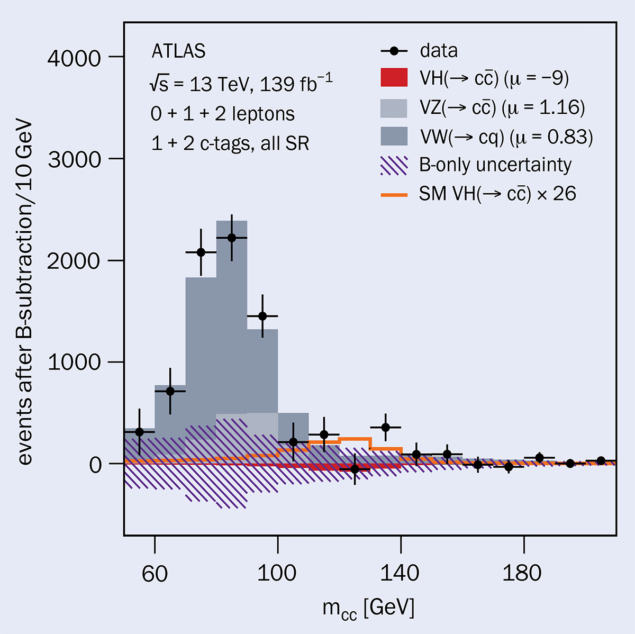A report from the ATLAS experiment.

Within the Standard Model (SM), the Higgs boson is predicted to interact with (or couple to) quarks with a strength proportional to their mass. By measuring these interaction strengths, physicists can test this prediction and gain insight into possible physics beyond the SM, where such couplings can be modified. In a new analysis exploiting the full Run-2 dataset, the ATLAS collaboration experimentally excludes new-physics scenarios which predict that decays of the Higgs boson to a pair of charm quarks (H → cc) are as frequent as those to bottom quarks (H → bb).
The search for H → cc is hampered by abundant background processes. In order to identify charm–quark signatures, a new multivariate classification method was developed to identify charm hadrons within jets, while simultaneously reducing the probability of misidentifying jets originating from a bottom quark. To maximise the sensitivity to the signal, events with one or two charm-tagged jets were selected. Background processes were further suppressed by selecting Higgs-boson events produced together with a weak boson, VH(cc), where the weak boson (V = W or Z) decays to 0, 1 or 2 electrons or muons. In total, 44 regions were fitted simultaneously to measure the H → cc process.
In the SM, the H → cc process accounts for only 3% of all Higgs-boson decays. The ATLAS analysis found no significant sign for this process in the data, setting an upper limit on the rate of the VH(cc) process 26 times the SM rate at 95% confidence level. This limit constrains the Higgs-to-charm coupling strength to less than 8.5 times the predicted SM value. The analysis strategy is validated by measuring events with two vector bosons that contain the decay of a W boson to one charm quark, VW(cq), or the decay of a Z boson to two charm quarks, VZ(cc), whose rates are found to agree with the predictions. The combined dijet-mass distribution, after subtraction of the backgrounds, is shown in figure 1.

Since H → cc and H → bb decays lead to very similar signatures in the ATLAS detector, a combined analysis of both processes is key to a common interpretation. The multivariate classification method is used to identify jets as originating from a bottom quark, a charm quark or lighter quarks. Since a fraction of the H → bb events passes the selection criteria of the H → cc analysis and vice versa, the individual analyses are designed to ensure that no collision events are counted twice. This orthogonality between the analyses enabled a simultaneous measurement of the two processes for the first time.
Within the SM, the ratio of the couplings of bottom and charm quarks to the Higgs boson is given by their mass ratio: mb/mc = 4.578 ± 0.008, obtained from lattice-QCD calculations. With its novel combination of H → cc and H → bb decays, the ATLAS analysis excludes the hypothesis that the Higgs-boson interaction with charm quarks is stronger than or equal to the interaction with bottom quarks at 95% confidence level (figure 2). For the first time, this measurement establishes that the Higgs-boson coupling is smaller for charm quarks than for bottom quarks.
Further reading
ATLAS Collab. 2022 arXiv:2201.11428.





